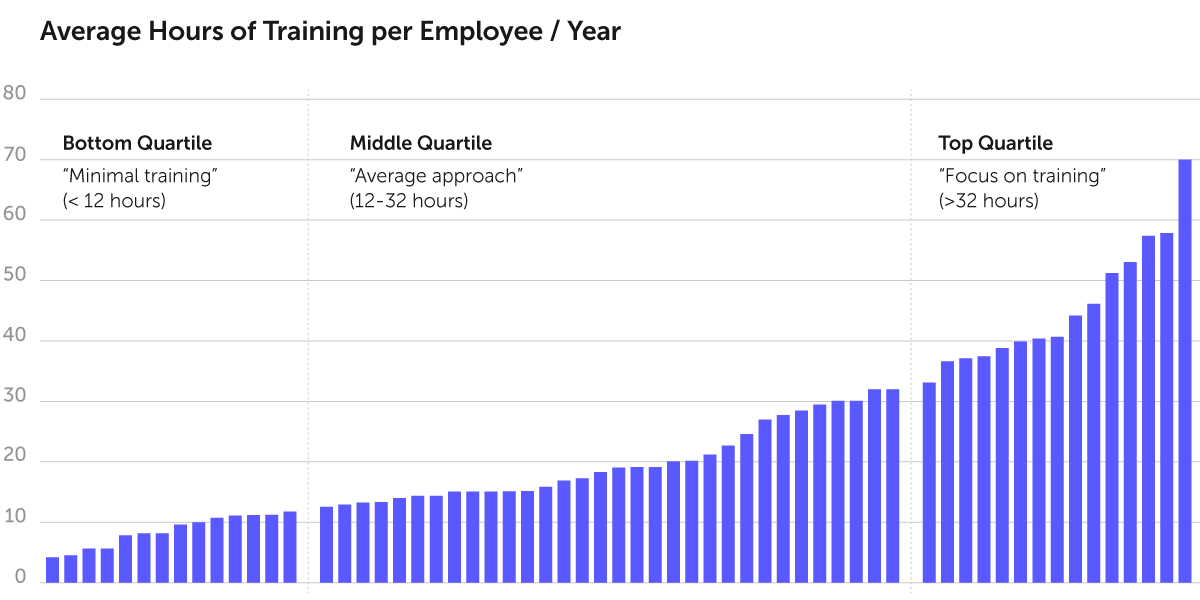Top companies invest in learning to future proof their business
What is the best approach toward optimizing learning investments? We found that top companies offer 2-3 times more training for employees than the rest.

We have analyzed a number of company reports to identify different approaches to learning investments and evaluate how companies could improve the effectiveness of their corporate training. We found that top companies offer 2-3 times more training for employees than the rest.
One of the key drivers for company success and competitive advantage in the modern economy are the intangible assets. Whether it is a great brand, streamlined production, or innovative R&D processes, success relies on Intellectual Capital, or more specifically on the Human Capital.
Companies have different and overlapping objectives for their training programs. Often the objectives relate to closing the skill-gap by re-skilling employees, creating a work culture of productivity, improving organizational agility, motivating employees, and to have an overall positive impact on business goals.
Training metrics from GRI Sustainability Reporting Standards
The best way to analyze the issue would be to look at companies’ Corporate Learning Strategy, training plans, budgets and content, and to run analytics with the data from their Corporate Learning Platforms. Obviously this data is not publicly available, so comparing companies is not straightforward.
However, as training metrics are included in the GRI Sustainability Reporting Standards framework (Global Reporting Initiative), some companies report these metrics as part of their Corporate Responsibility / Sustainability reporting. From these reports, a specific metric for “number of training hours” can be used as a proxy of the Corporate Learning approach and Human Capital investments, acknowledging that it doesn’t directly show how effective the training was, i.e. how well the training succeeded in achieving the training objectives.
In our study, we have analyzed a sample of GRI Sustainability reports of large European and US companies who have published the related training metrics (G4-LA9: Average hours of training). This sample includes a total of 60 companies across industries, 32 based in Finland, 13 in the US, 7 in the UK, 3 in Germany, and 1 in both Denmark and France. While the sample size is relatively small, it indicates that there are surprisingly large differences between companies in terms of the amount of training (in hours) they provide to their employees per year.
How many hours are used in training?
The following picture outlines average training hours per employee by company. The companies have been further grouped into three groups based on descriptive statistics quartiles:
- Minimal training approach (Bottom quartile) – These companies seem to have a minimalistic / cost-cutting approach towards employee training and are offering on average less than 12 hours of training per employee per year. This is significantly lower than for the peer group (average across all companies in study is 23,6 hours of training per person).
- Average approach (Middle quartiles)– These companies, with a similar approach to their peers, offer between 12 and 32 hours of training per employee per year on average. This covers the majority of companies in the study.
- Focus on training approach – These companies place a substantial focus on employee training and offer more than 32 hours of training per employee per year.

The different training approaches raise further questions and improvement opportunities for these companies:
- Companies in the bottom quartile might put continuous improvement, future innovations and employee engagement at risk due to low training investments. They should assess opportunities for cost-effective ways to increase relevant training offerings for employees. One of the first steps is to ensure the company has a Corporate Learning Platform that effectively handles the production and delivery of the training content
- Companies in the middle quartiles should focus on improving the training effectiveness, e.g. ensuring achievement of training objectives by establishing learning reporting and analytics framework to measure and monitor learning progress and outcomes.
- Companies in the top quartile are making significant investments to future proof their business in terms of human capital. These companies must ensure they continue to receive value for their investment and offer new training objectives. These companies may also benefit from advanced learning analytics and insights to drive tangible business outcomes. Analytics will provide the required insights to further optimize the learning experience by providing user specific training content.
Optimize learning to achieve your business goals
In our earlier white paper “Five Best Practices in Optimizing Learning Experiences for Organizations” we discussed some ways to improve learning effectiveness. These include:
- Online learning should make learning faster, more efficient, and consistent by making relevant training quickly and readily available for learners.
- Training should be personalized to suit the varying needs of your learners, taking into consideration functions such as geolocation, collaboration, interface personalization, and customized learning paths.
- Organizations must actively seek efficient ways to minimize the loss of knowledge through employee retention and/or effective experiential knowledge management.
- Utilizing resources to measure the learning impact effectively will make a difference in the quality of training provided and, therefore, the organizational performance. How learning data can show if the learning is making the difference wanted in the employees.
Towards optimized learning investments
Contact our learning transformation consultants to discuss the right approach towards optimizing learning investments for your organization. Key considerations and next steps relate to having a clearly defined corporate learning strategy, which requires understanding where your organization currently stands, what the targeted business outcomes are, and an indicative timeline for your learning transformation.
- Define the key business outcomes for the training investment
- Benchmark your organisational learning culture together with our SME’s / Learning professionals
- Design what kind of training approach fits best for your organisation
- Build the metrics that can be used to follow-up the process
References:




